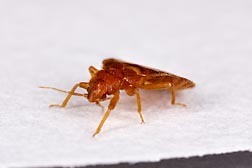|
|
|
Fresh from the Field is a weekly album showcasing transformative impacts made by grantees funded by the National Institute of Food and Agriculture.
June 8, 2017
|
|
Success Stories
 Family tree of forestry
Surveys show that the
average forest landowner is over 60 years old. A recent Pennsylvania
State University project looked at the issue of intergenerational land
transfer to help land-owning families preserve forests and address other
challenges, such as invasive species. The University's Center for Private Forests provides education and outreach to
private forest landowners to connect people to the land and encourage
stewardship beyond the current generation. The project was made possible with
support from NIFA’s Renewable
Resources Extension Act-National Focus Fund Projects (RREA-NFF).
Read more about the Center for Private Forests.
|
 Training growers on food safety
Roughly
one in six Americans (48 million people) get sick from foodborne diseases,
according to the Centers for Disease Control. With support from NIFA's Food
Safety Outreach Program, the University of Florida launched the Southern
Center for Training, Education, Extension, Outreach, and Technical Assistance
to Enhance Produce Safety. The Southern Center seeks to build a collaborative
infrastructure in southern states to support produce safety training and
education that is compliant with the Food Safety Modernization Act (FSMA).
Thirteen regional land-grant institutions participate in the Center. Their
Food Safety and Preventative Controls Alliance (FSPCA) instructional training
continues to grow. To date, 52 FSPCA instructors have trained 830 participants
and 108 Produce Safety Alliance (PSA) trainers. The PSA trainers have trained
136 participants, including program evaluators.
Read more about the Southern Center.
|
News Coverage
 Don't let the bed bugs bite
You
may think the best solution for bed bugs is insecticides. People, however, often
overlook nonchemical methods of pest management, such as decluttering and bug
traps. Prevention is critical in multi-unit housing where bed bugs
are very difficult to eliminate.
With
NIFA funding, Alvaro Romero, a scientist from the New Mexico State
University is working with other researchers to educate the public about
using an integrated pest management approach to detect and prevent bed bugs.
Read the Las Cruces Sun News story.
|
 The coast is clear
June
marks the beginning of the Atlantic hurricane season. It’s important for East
Coast communities to be prepared for storms and natural disasters that can affect
health and safety, limit access to roads, cause property and tree damage, and
loss of electricity.
At the Universities of
Connecticut and Rhode Island, a team of Extension and Sea Grant educators
is addressing coastal preparedness with funding from the Smith-Lever Special Needs Competitive Grants Program. UConn
Extension has created a preparedness education program to help people,
including those with pets and livestock, prepare for storm emergencies. UConn Extension’s EDEN (Extension Disaster Education Network)
website contains a range of research-based emergency
preparedness resources.
Pamela Rubinoff, a
researcher from the University of Rhode Island is developing Rapid PACE
(rapid Property Assessment of Coastal Exposure), a storm mapping, assessment, and planning tool for municipal officials and coastal communities.
The tool aggregates map data from multiple
sources to generate user-friendly reports that pinpoint how storms affect
particular parcels of land in coastal Rhode Island.
Learn
more about New England emergency
preparation
efforts.
|
Video
 NC State Extension on the front lines
In
2016, Hurricane Matthew was the first Category 5 storm to hit the East Coast
since 2007. Massive recovery efforts took place all over Eastern North Carolina
in the wake of the storm. With NIFA
funding, North Carolina State Extension was front and center in the
hardest-hit counties.
“Our
agents jumped in and did a great job helping to address human needs,” said Mike
Yoder, Extension coordinator of emergency programs, who was embedded with the North
Carolina Emergency Operations Center during the crisis.
Hurricane
Matthew left hundreds of roads in eastern North Carolina impassible, which made
getting feed to livestock difficult. Specialists and agents also served as a critical
link between farmers and state-level organizations, quickly relaying urgent
information.
“We
all know Extension is not an 8-to-5 job,” said Extension Director Rich Bonanno.
“I’m really proud to be at the head of an organization where people are so
dedicated to what they do. This was a situation where there was a lot of
pressure … a lot of things needed to happen fast, and I’m thankful that our
people really showed what they were made of."
View the NC extension video.
|
Tweet of the Week
#NIFAIMPACTS

|
|

For more NIFA Impacts, visit nifa.usda.gov/impacts or the Land-Grant University Impacts website. Send us your NIFA-funded impacts at impactstories@nifa.usda.gov or share them on Twitter @USDA_NIFA, #NIFAimpacts.
NIFA invests in and advances agricultural research, education, and extension and promotes transformative discoveries that solve societal challenges.
Fresh from the Field is a weekly compendium of news and information that may be of interest to land-grant and non-land-grant universities, NIFA stakeholders, and other subscribers.
Editor: Falita Liles, Co Editor: Carlos Harris
|
|